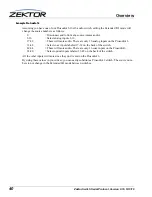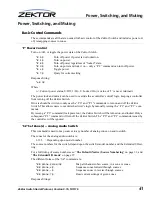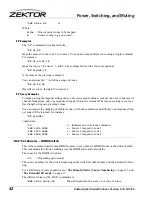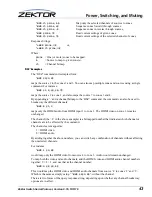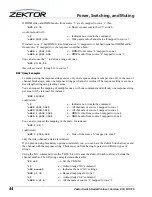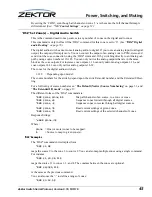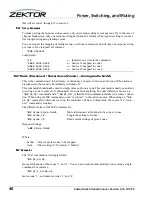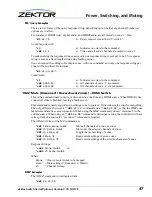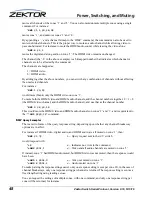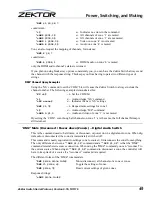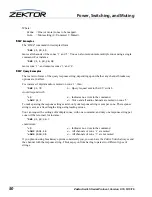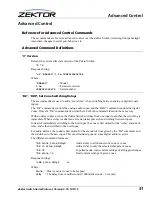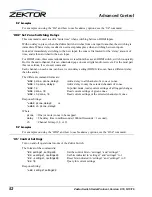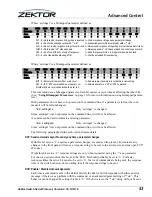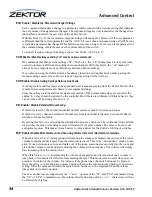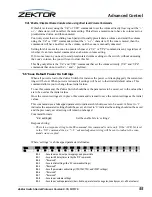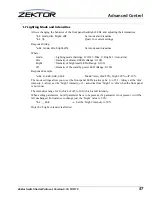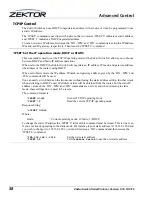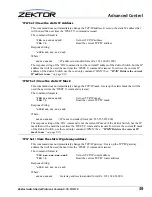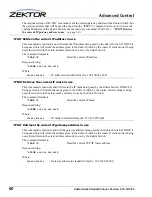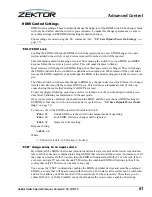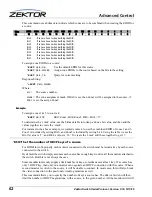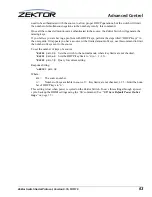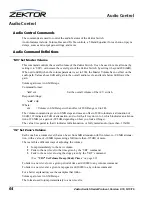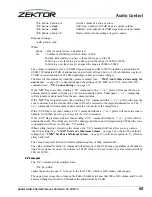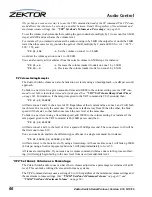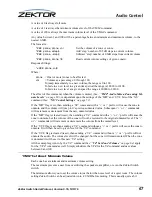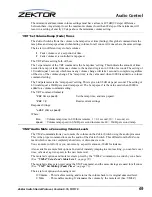
54
Zektor Switch Serial Protocol, Version 0.16, 5/13/16
Advanced Control
‘ECO’ Enable / Disable the ‘Parameter Changed’ Strings
Each command that makes a change to a parameter, will be echoed with a response string that indicates
the new values of the parameters changed. The response strings are only issued after the changes have
taken affect, and reflect the new state of the Zektor Switch.
With this bit set to ‘0’, these automatic response strings will not be sent. However if the new parameter
is different than the current parameter, and the ‘ASY’ bit is set, then a response string will still be sent
to indicate a parameter has changed. This bit forces a response string to be sent even if the parameter of
the command being sent is the same as the current value of the switch.
To stop all response strings from being sent, set this bit the ‘ASY bit to ‘0’.
‘CHM’ Enable / Disable always sending“.ch” masks on zone commands
On commands that change zone settings (‘SZ’, ‘MZ’, etc.), the “.ch” channel mask is only sent when
needed to indicate a difference in settings between channels. With this bit set, the “.ch” mask will
always be sent, regardless of any differences between channel settings.
If you plan on using the Zektor Switch’s breakaway functions, setting this bit can make parsing the
response strings easier, since only one type of response string will be returned.
‘CRE’ Enable / Disable trailing Carriage Returns Line Feeds
A carriage return and line feed can be appended to all responses coming from the Zektor Switch. This
is useful when using terminal software to test command strings.
Since the carriage returns and line feeds are sent outside of the normal string (they are sent after the
ending ‘
$
’), they should be ignored by the controller. But if there are problems with this behavior, they
can be turned off by setting this bit to a ‘0’.
‘XIO’ Enable / Disable Extended I/O numbering
If this bit is reset (0), the normal, sequential number system is used for sources and zones.
If this bit is set (1), then an extended I/O number system is used that is the same between all Zektor
switches of the same family.
By setting this bit to one (1) during the initialization process, a driver can be written that treats all Zek-
tor switches the same. All analog sources will start with the same number. The same is true for coax
and optical sources. This makes it much easier to write a driver for the Zektor’s full line of switches.
‘MJP’ Enable / Disable Mute Volume Jump when using Volume Increment / Decrement commands
When this bit is set to ‘0’ incrementing/decrementing the volume of a muted zone will cause the zone’s
volume to increment/decrement from the current muted level. This is the “no surprises” mode of oper-
ation. If one person mutes a zone and walks out of the room, someone else can walk into the room and
pick up the volume control and start adjusting the volume with no surprises. The volume will simply
start increasing from the current level.
When this bit is set to ‘1’ incrementing the volume of a muted zone will cause the zone’s volume to
jump back to its unmuted level before incrementing the level. This mode is most useful when only one
person is in control of the volume. For instance if the phone rings, the mute button can be pressed.
Once the call is over, pressing any volume button will cause the volume to jump back to it’s previous
setting. Since the same user pressed the mute button, he/she won’t be surprised when the volume
jumps back to its previous value.
The above behaviors are supported by the ‘+’ and ‘-’ options of the ‘VZ’ and ‘VPZ’ commands. Using
the ‘VZ’ or ‘VPZ’ commands to set the volume directly (leaving out the ‘+’ or ‘-’ characters), will not
be affected by this flag.

